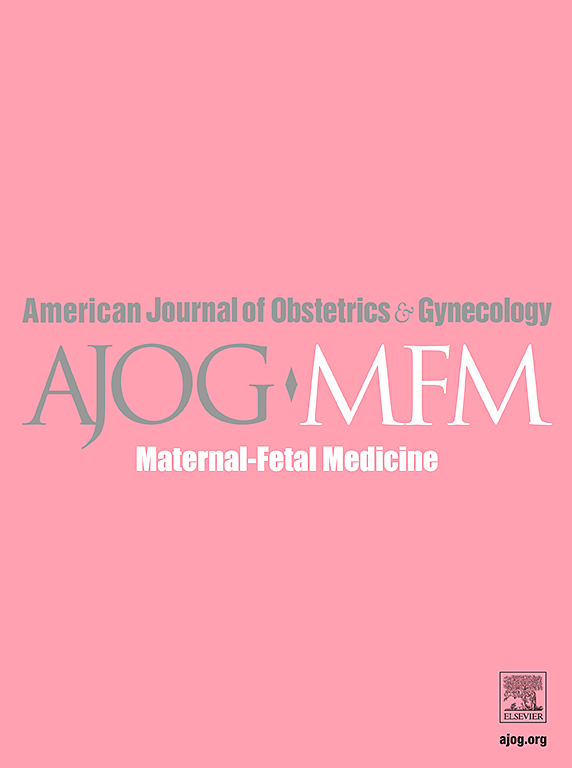实施妊娠期无症状细菌尿的检测、诊断和抗生素管理算法。
IF 3.8
2区 医学
Q1 OBSTETRICS & GYNECOLOGY
American Journal of Obstetrics & Gynecology Mfm
Pub Date : 2024-10-05
DOI:10.1016/j.ajogmf.2024.101516
引用次数: 0
摘要
背景:无症状菌尿(ASB)影响到 2-15% 的孕妇,其中 20-40% 的孕妇会在之后出现症状。无症状尿路感染(UTI)在孕期更为常见,发病率为 33%,会带来早产、低出生体重和孕妇肾盂肾炎等风险。尿路感染检测的金标准是尿液培养,但在产科定期就诊时,也会经常使用护理点尿液分析滴定管进行筛查。白细胞酯酶已被用于无症状患者的治疗,但其敏感性和特异性较低。确诊检查对于避免假阳性和确保最佳治疗效果至关重要。目前,有关妊娠期 ASB 的尿液分析测值解释和治疗决定的指南非常有限。目前还不清楚循证算法能否改善妊娠期 ASB 的检测利用率、诊断和治疗决策:我们研究的主要目的是开发、实施和评估一种循证算法,以指导常规产科就诊中孕妇无症状菌尿的尿液分析解读、培养、诊断和抗生素管理:研究设计:该项目包括回顾性和准实验性前瞻性病历审查,审查对象为妊娠超过 20 周、年龄在 18 岁及以上的妊娠期患者,这些患者在常规产科就诊时接受了尿液分析探针测试。一名临床实验室科学专业的博士生根据循证医学实践,开发了一套教育算法,用于指导尿液分析量表的解释、培养的必要性和治疗决策。我们的研究将 2022 年 2 月 1 日至 28 日的患者记录作为回顾性(算法实施前)数据,将 2023 年 1 月 24 日至 2 月 22 日的患者记录作为前瞻性(算法实施后)数据。从电子病历中收集的数据包括去标识化的患者信息、尿液分析结果、培养日期和结果、抗生素处方、UTI 或 ASB 诊断、提供者详细信息、不良妊娠结局和人口统计学特征。使用 SPSS 29 版进行的数据分析包括卡方检验、似然比和效应大小计算,以及 P 值 结果:在研究中,我们共检查了 1176 份病历。实施前的数据包括 440 份记录,其中 224 份尿检异常,216 份尿检正常。实施后的数据包括 736 份记录,其中 255 份异常,481 份正常。患者人口统计学特征主要为白人(87%),产妇年龄中位数为 27 岁,孕周为 32 周。我们的实施前分析表明,算法偏差与培养利用率之间都存在显著关联(P 结语):我们的研究结果表明,该算法的使用与随后的临床决策之间具有很强的一致性,突出了其在产科环境中加强患者护理和管理的潜力。值得注意的是,在审慎使用抗生素的医疗服务提供者中,对该算法的依从性更高。本文章由计算机程序翻译,如有差异,请以英文原文为准。
Implementation of an algorithm for testing, diagnosis, and antibiotic stewardship of asymptomatic bacteriuria in pregnancy
BACKGROUND
Asymptomatic bacteriuria affects 2% to 15% of pregnant women, with 20% to 40% developing symptoms later. Symptomatic urinary tract infections are more common in pregnancy, with a prevalence of 33%, posing risks, such as preterm delivery, low birthweight, and maternal pyelonephritis. The gold standard for urinary tract infection detection is a urine culture, but point-of-care urinalysis dipsticks are frequently performed as screens during regular obstetrical visits. Leukocyte esterase has been used to justify the treatment of asymptomatic bacteriuria, even with low sensitivity and specificity. Confirmatory tests are crucial for avoiding false positives and ensuring optimal outcomes. Current guidelines for urinalysis dipstick interpretation and the decision to treat asymptomatic bacteriuria in pregnancy are limited. It remains unclear whether an evidence-based algorithm can improve test utilization, diagnosis, and treatment decisions for asymptomatic bacteriuria in pregnancy.
OBJECTIVE
The primary objective of our study was to develop, implement, and evaluate an evidence-based algorithm to guide urinalysis interpretation, culture, diagnosis, and antibiotic stewardship of asymptomatic bacteriuria in pregnant patients during routine obstetric visits.
STUDY DESIGN
The project involves both retrospective and quasi-experimental prospective medical record reviews of pregnant patients aged ≥18 years, beyond 20 weeks of gestation, from routine obstetrical visits with urinalysis dipstick tests. A doctorate in clinical laboratory sciences student developed an educational algorithm to guide urinalysis dipstick interpretation, culturing necessity, and treatment decisions based on evidence-based practice. Our study considered patient records from February 1, 2022, to February 28, 2022, as retrospective (prealgorithm implementation) data and January 24, 2023, to February 22, 2023, as prospective (postalgorithm implementation) data. Data collected from the electronic medical record included deidentified patient information, urinalysis results, culture dates and outcomes, antibiotic prescriptions, urinary tract infection or asymptomatic bacteriuria diagnoses, provider details, adverse pregnancy outcomes, and demographics. Data analysis using SPSS (version 29; SPSS IBM, Armonk, NY) involved chi-square tests, likelihood ratios, and effect size calculations, with P values of <.05 considered statistically significant.
RESULTS
This study examined a total of 1176 patient records. Preimplementation data included 440 records, of which 224 were abnormal urinalyses and 216 were normal urinalyses. Postimplementation data included 736 records, of which 255 were abnormal urinalyses and 481 were normal urinalysis. The patient demographics predominantly featured White individuals (87%), with a median maternal age of 27 years and a gestational age of 32 weeks. Our preimplementation analyses revealed significant associations of algorithm deviations with both culture utilization (P<.001) and antibiotic stewardship (P<.001). However, no significant association was observed between algorithm deviations and adverse patient outcomes. Culture underutilization decreased significantly from 43.0% (189/440) before implementation to 29.5% (217/736) after implementation (P<.001). The overall reduction in asymptomatic bacteriuria prevalence from 16.3% (8/49) to 6.7% (10/67) suggests a decrease of nearly 60.0%. In addition, antibiotic overprescription decreased significantly from 1.6% (4/258) before implementation to 0.8% (4/522) after implementation (P=.003), with a reduction from 7.1% (3/42) to 2.4% (1/41) among abnormal urinalyses.
CONCLUSION
Our findings show a strong alignment between the use of the algorithm and subsequent clinical decisions, underscoring its potential to enhance patient care and management in obstetrical settings. Adherence to the algorithm was higher among providers displaying prudent antibiotic use.
求助全文
通过发布文献求助,成功后即可免费获取论文全文。
去求助
来源期刊

American Journal of Obstetrics & Gynecology Mfm
Medicine-Medicine (all)
CiteScore
7.40
自引率
3.20%
发文量
254
审稿时长
40 days
期刊介绍:
The American Journal of Obstetrics and Gynecology (AJOG) is a highly esteemed publication with two companion titles. One of these is the American Journal of Obstetrics and Gynecology Maternal-Fetal Medicine (AJOG MFM), which is dedicated to the latest research in the field of maternal-fetal medicine, specifically concerning high-risk pregnancies. The journal encompasses a wide range of topics, including:
Maternal Complications: It addresses significant studies that have the potential to change clinical practice regarding complications faced by pregnant women.
Fetal Complications: The journal covers prenatal diagnosis, ultrasound, and genetic issues related to the fetus, providing insights into the management and care of fetal health.
Prenatal Care: It discusses the best practices in prenatal care to ensure the health and well-being of both the mother and the unborn child.
Intrapartum Care: It provides guidance on the care provided during the childbirth process, which is critical for the safety of both mother and baby.
Postpartum Issues: The journal also tackles issues that arise after childbirth, focusing on the postpartum period and its implications for maternal health. AJOG MFM serves as a reliable forum for peer-reviewed research, with a preference for randomized trials and meta-analyses. The goal is to equip researchers and clinicians with the most current information and evidence-based strategies to effectively manage high-risk pregnancies and to provide the best possible care for mothers and their unborn children.
 求助内容:
求助内容: 应助结果提醒方式:
应助结果提醒方式:


